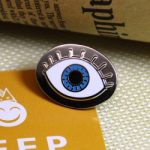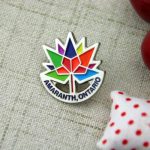Enamel Pins
To trace the origin of the Brooch goes all the way back to Stone Age. Research shows that the Ancients used animal skins or sharp animal or fish bones or even thorns to fasten. The Brooch or lapel pin of course has evolved since then, and now can reflect any shape or image and is a significant piece of fashion today.
So many people want lapel pins more than before. I’m sure many people are interested in knowing how custom enamel lapel pins are made! Let us show you how to make enamel pins now.
Step 1: Design Drawing
The perfect design is the soul of the custom enamel pins, we will design drawings according to customer requirements.
Step 2: Finish 3D Model
The customer confirmed design drawings that are forwarded to the factory mold department programmer. After the 3D model is finished, the production of the lapel pins can start. A piece of black steel that is a mold material, fixed in the engraving machine, the computer program will be compiled according to the 3D model in the black steel, and remove the excess metal parts. Patterns are gradually formed, which is a slow process. Because of different sizes, different complexity of the design, engraving time spent is not the same. The short only a few hours, while the long take a few days to complete mold making.

After the mold is completed, our staff needs to carefully compare the mold pattern with the design drawings to ensure that the mold pattern is correct. The mold cannot be used immediately, because we need to put the mold into the high-temperature oven to bake to reduce the hardness of the mold. This is a simple heat treatment process, but it is an important process of making enamel pins. Finally, we put it immediately into the oil to cool, to further increase the hardness and toughness of the mold.
Step3: Die Struck
We will also set a steel ring at the outside of the cooling mold. The reason for this is to protect the mold so it’s not damaged in the stamping process. We use a hydraulic machine to fix the mold, the following we can start the beginning process. This process is what we call DIE STRUCK.

The material selected for this is iron, copper, zinc alloy, aluminum, and so on. When the first blank pin comes out, we need to carefully check the blank custom pin and design is the same. If there is a little flaw, we need to modify the mold or even re-engraved new mold. After checking is complete, if there is no problem we will start mass production on the order. After mass production, we need to remove the extra part with a knife installed on the machine.
Step 4: Grinding and Vibration
In order for the enamel pins to come out smoothly, we put all blanks into the grinding machine to shock. This will cause the blanks to start collision and friction so that it gives the pins a simply polished.
Step 5: Add Attachments
There are so many specific names for lapel pins, cuff links, a hat clip, etc. Different accessories led to different purposes of the badge, so the names are different. We equipped our production with a very wide range of accessories, “thorn needle, butterfly clutch, safety pin, magnet, etc.” Thorn needles currently have two kinds of assembly methods to fix, one is to glue the thorn needle stuck in the back of the product (this way because of a long-time glue aging, resulting in thorn needle easy to fall off) And another way is silver welding (welding thorn horseshoe needle is very strong, and it will not fall off and fix for so long time).
Step 6: Polishing
Polishing is a very important part of the production process, I believe no one is willing to buy such productions which have a rough badge and scratches on the surface. We are responsible for every customer, so we are very strict about polishing.
The polishing grinding wheel is divided into many kinds, there is a hard sand wheel, soft cloth wheel, and so on. If smooth requirements are not high, we can use the grinding sand wheel directly polished production, if customers want to get a smooth surface or mirror gloss, we need to use the cloth wheel to polish productions.
Each custom enamel pin will be a separate polished and the worker carefully controls the contact with the cloth wheel to ensure that the polished surface can be polished. After polishing, side polishing is still done by hand, one by one individually polished.
Step 7: Electroplating
Polished pins will be sent to electroplating, which is according to the customer’s demand. There is bright gold, bright silver, bright red copper, antique gold, antique silver, antique copper, and so on.
With the copper wire for the custom-made pins, one by one is strung together invading the syrup. The first step is to use ultrasonic oil in order to remove the pins in the previous production process stained with a variety of oil. Through the sound waves generated overclocking vibration, so that oil separates from the enamel pins surface. After they are oiled, pins will need to be washed to get rid of the syrup.
And then, we start to plate. Infiltration with alkali copper liquid, pins are coated with metal color. Usually different plating colors, the number of coloring will be different. Red copper can be plated twice, three times silver, four times gold. It is the end of the plating when enamel pins are sent into the oven for baking.
Step 8: Coloring
Color is divided into soft enamel and hard enamel. Soft enamel pins are one of our most popular styles. Metal areas are raised, colors are recessed.

Hard enamel pins color is smooth and delicate giving a very upscale feeling. Contract color card and design draft, the color worker needs to mix the color and many places that need to color can be very small. The color worker sucks the color with a needle and colors it by hand. Until the color is completed the quality inspection master carefully checks the color of the pins. If there is no problem, the badge is put into the oven at high temperatures to make the paint solid and fixed on the pin.
The above is about soft enamel pins color. Hard enamel pins color order is not the same. We need to electroplate at first, and then to color, while the latter is plating at first, coloring second, plating third. In other words, hard enamel pins need to polish twice. In addition, after coloring, we need to deal with the problem of uneven color because the liquid properties before baking will cause the solidified color surface to be rugged. The product needs to be polished again, and the pins need to be washed to prevent being damaged by high temperatures.
Step 9: Packaging
The last quality inspection is made before packaging. Only qualified productions were sent anywhere in the world by land transport or air transport. We can provide different packaging according to different requirements for customers. Ziploc bag is most common. Besides, we provide paper cards, velvet pouch, velvet box, plastic box.
Did you understand the process of making custom enamel pins through videos or reading our texts? If you have any other doubts, you can leave a message text comments, or directly go to our homepage GS-JJ.COM and contact us online, we would like to help customers answer the doubts.


